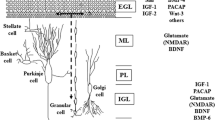Abstract
1. Midkine (MK) is known to be a member of a family of heparin-binding neurotrophic factors. We used a chemically defined culture system to examine neuronal activities of MK on embryonic rat cerebellar cells.
2. In the culture system, a substrate surface was chemically modified either with amine or with laminin peptide to homogenize substrate conditions for culturing neurons.
3. At the optimal concentration (2.5 ng/ml), MK moderately promoted survivability (1.3-fold) and accelerated neurite outgrowth (1.4-fold) of cerebellar cells, putatively granule neurons, grown on an amine-modified surface.
4. Higher dosages (10 ng/ml or more) of MK, however, caused cellular fragmentation and detachment. Such degenerative effects were diminished by increasing the surface adhesiveness using laminin peptide, suggesting that the cellular degeneration might be caused by changes in the adhesive property of the neuron.
5. Using this culture system, we have found that MK has a novel modulatory activity of neuronal adhesiveness on the cultured cerebellar granule cells. Together with the expression pattern of MK, our study supports the idea that MK may be involved in the developmental events of the cerebellum.
Similar content being viewed by others
REFERENCES
Kadomatsu, K., Tonomura, M., and Muramatsu, T. (1988). cDNA cloning and sequencing of a new gene intensity expressed in early differentiation stages of embryonal carcinoma cells and in midgestation period of mouse embryogenesis. Biochem. Biophys. Res. Commun. 151: 1312–1318.
Kadomatsu, K., Huang, R., Suganuma, T., Murata, F., and Muramatsu, T. (1990). A retinoic acid responsive gene MK found in the teratocarcinoma system is expressed in spatially and temporally controlled manner during mouse embryogenesis. J. Cell Biol. 110: 607–616.
Kaneda, N., Talukder, A. H., Ishihara, M., Hara, S., Yoshida, K., and Muramatsu, T. (1996). Structural characteristics of heparin-like domain required for interaction of midkine with embryonic neurons. Biochem. Biophys. Res. Commun. 220:108–112.
Kikuchi, S., Muramatsu, T., and Kim, S. U. (1993). Midkine, a novel neurotrophic factor, promotes survival of mesencephalic neurons in culture. Neurosci. Lett. 160:9–12.
Kojima, S., Inui, T., Muramatsu, H., Kimura, T., Sakakibara, S., and Muramatsu, T. (1995). Midkine is a heat and acid stable polypeptide capable of enhancing plasminogen activator activity and neurite outgrowth extension. Biochem. Biophys. Res. Commun. 216:574–581.
Li, Y., Milner, P. G., Chauhan, A. K., Watson, M. A., Hoffman, R. M., Kodner, C. M., Milbrandt, J., and Deuel, T. F. (1990). Cloning and expression of a developmentally regulated protein that induces mitogenic and neurite outgrowth activity. Science 250:1690–1694.
Matsumoto, K., Wanaka, A., Mori, T., Taguchi, A., Ishii, N., Muramatsu, H., Muramatsu, T., and Tohyama, M. (1994a). Localization of pleiotrophin and midkine in the postnatal developing cerebellum. Neurosci. Lett. 178:216–220.
Matsumoto, K., Wanaka, A., Takatsuji, K., Muramatsu, H., Muramatsu, T., and Tohyama, M. (1994b). A novel family of heparin-binding growth factors, pleiotrophin and midkine, is expressed in the developing rat cerebral cortex. Dev. Brain Res. 79:229–241.
Matsuzawa, M., Liesi, P., and Knoll, W. (1996). Chemically modifying glass surfaces to study substratum-guided neurite outgrowth in culture. J. Neurosci. Meth. 96:189–196.
Michikawa, M., Kikuchi, S., Muramatsu, H., and Kim, S. U.(1993). Retinoic acid responsive gene product, midkine, has neurotrophic functions for mouse spinal cord and dorsal root ganglion neurons in culture. J. Neurosci. Res. 35:530–539.
Mount, H. T. J., Dreyfus, C. F., and Black, I. B. (1994). Neurotrophin-3 selectively increases cultured Purkinje cell survival. NeuroReport 5:2497–2500.
Muramatsu, H., and Muramatsu T. (1991). Purification of recombinant midkine and examination of its biological activities: Functional comparison of new heparin binding factors. Biochem. Biophys. Res. Commun. 177:652–658.
Muramatsu, H., Shirahama, H., Yonezawa, S., Maruta, H., and Muramatsu, T. (1993). Midkine, a retinoic acid-inducible growth/differentiation factor: Immunochemical evidence for the function and distribution. Dev. Biol. 159:392–402.
Muramatsu, H., Inui, T., Kimura, T., Sakakibara, S., Song, X., Maruta, H., and Muramatsu, T. (1994). Localization of heparin-binding, neurite outgrowth and antigenic regions in midkine molecule. Biochem. Biophys. Res. Commun. 203:1131–1139.
Muramatsu, T. (1994). The midkine family growth/differentiation factors. Dev. Growth Differ. 36:1–8.
Rauvala, H. (1989). An 18-kd heparin-binding protein of developing brain that is distinct from fibroblast growth factors. EMBO J. 8:2933–2941.
Rohler, H. (1990). The role of growth factors in the control of neurogenesis. Eur. J. Neurosci. 2:1005–1015.
Take, M., Tsutsui, J., Obama, H., Ozawa, M., Nakayama, T., Maruyama, I., Arima, T., and Muramatsu, T. (1994). Identification of nucleolin as a binding protein for midkine (MK) and heparin-binding growth associated molecule (HB-GAM). J. Biochem. 116:1063–1068.
Tanimori, H., Kitagawa, N., Tsunoda, R., and Tsuchiya, R. J. (1981). Enzyme immunoassay of neocarzinostatin using β-galactosidase as label. J. Pharm. Dyn. 4:812–819.
Tashiro, K., Sephel, G. C., Weeks, B., Sasaki, M., Martin, G. R., Kleinman, H. K., and Yamada, Y. (1989). A synthetic peptide containing the IKVAV sequence from the A chain of laminin mediates cell attachment, migration, and neurite outgrowth. J. Biol. Chem. 264:16174–16182.
Wewetzer, K., Rauvala, H., and Unsicker, K. (1995). Immunocytochemical localization of the heparin-binding growth-associated molecule (HB-GAM) in the developing and adult rat cerebellar cortex. Brain Res. 693:31–38.
Author information
Authors and Affiliations
Corresponding author
Rights and permissions
About this article
Cite this article
Matsuzawa, M., Muramatsu, T., Yamamori, T. et al. Novel Neuronal Effects of Midkine on Embryonic Cerebellar Neurons Examined Using a Defined Culture System. Cell Mol Neurobiol 19, 209–221 (1999). https://doi.org/10.1023/A:1006925110584
Issue Date:
DOI: https://doi.org/10.1023/A:1006925110584




